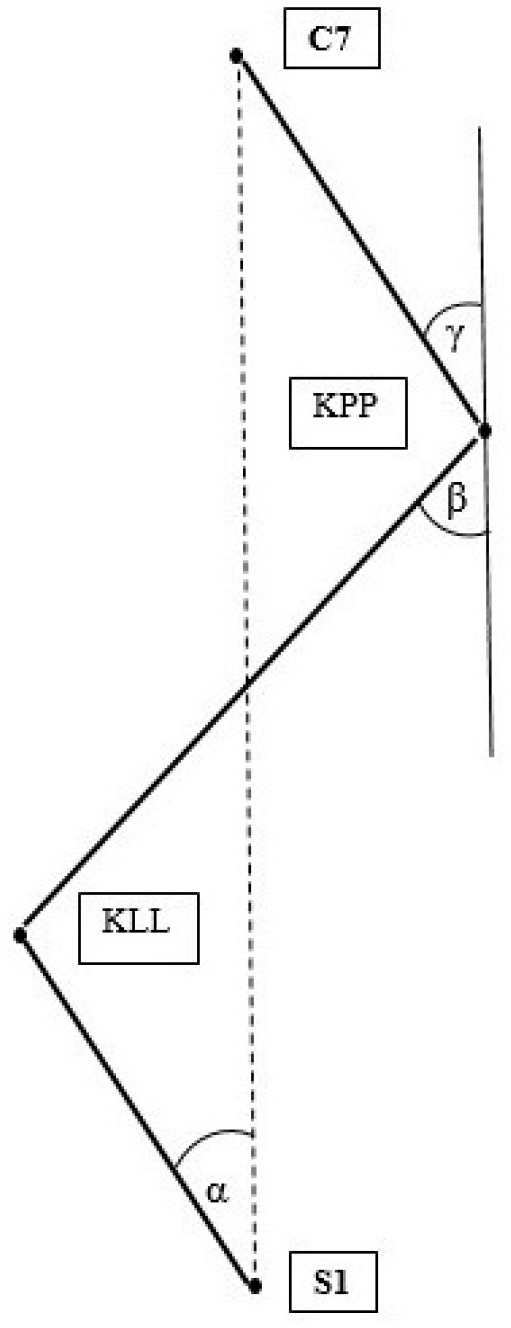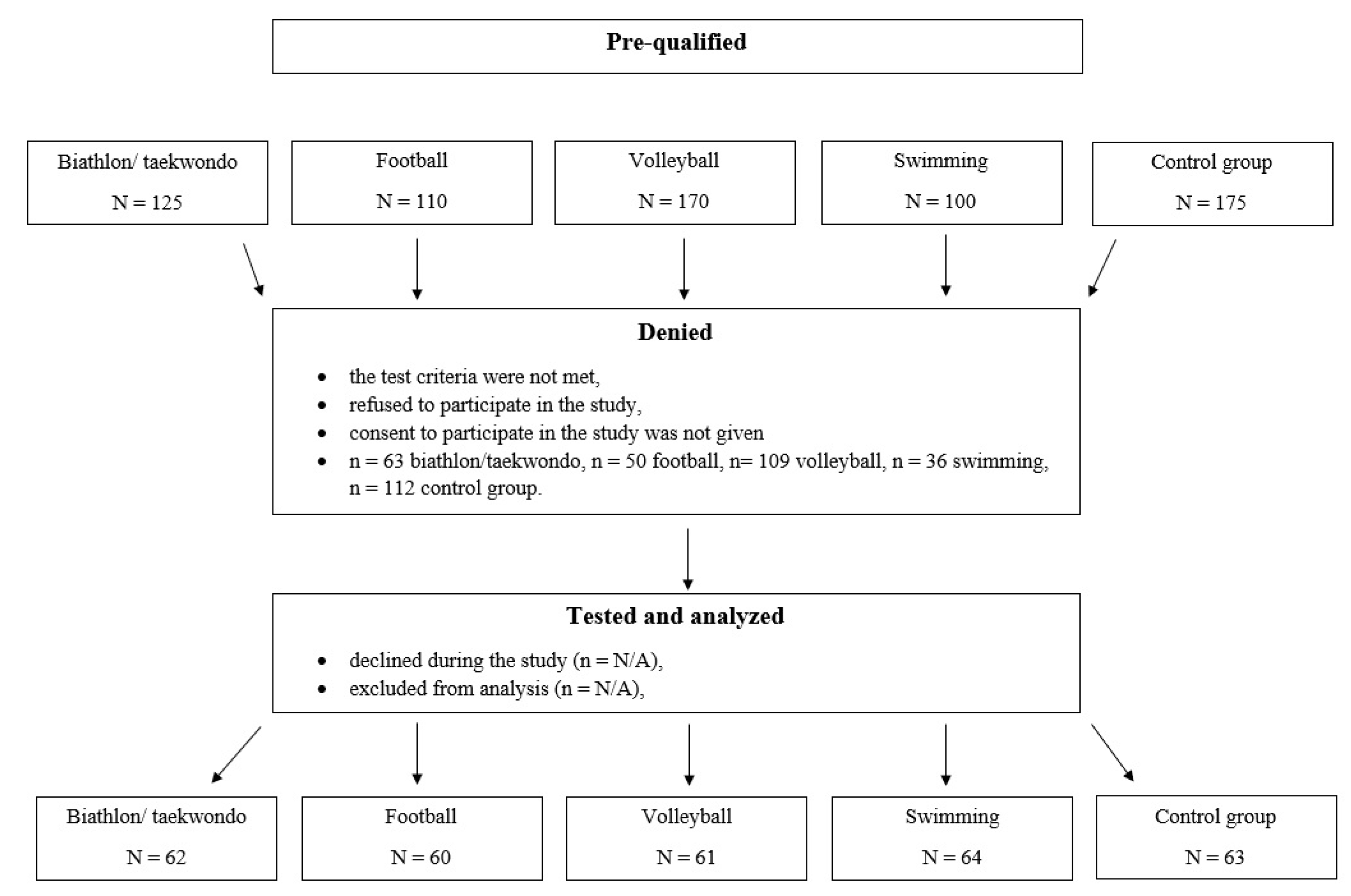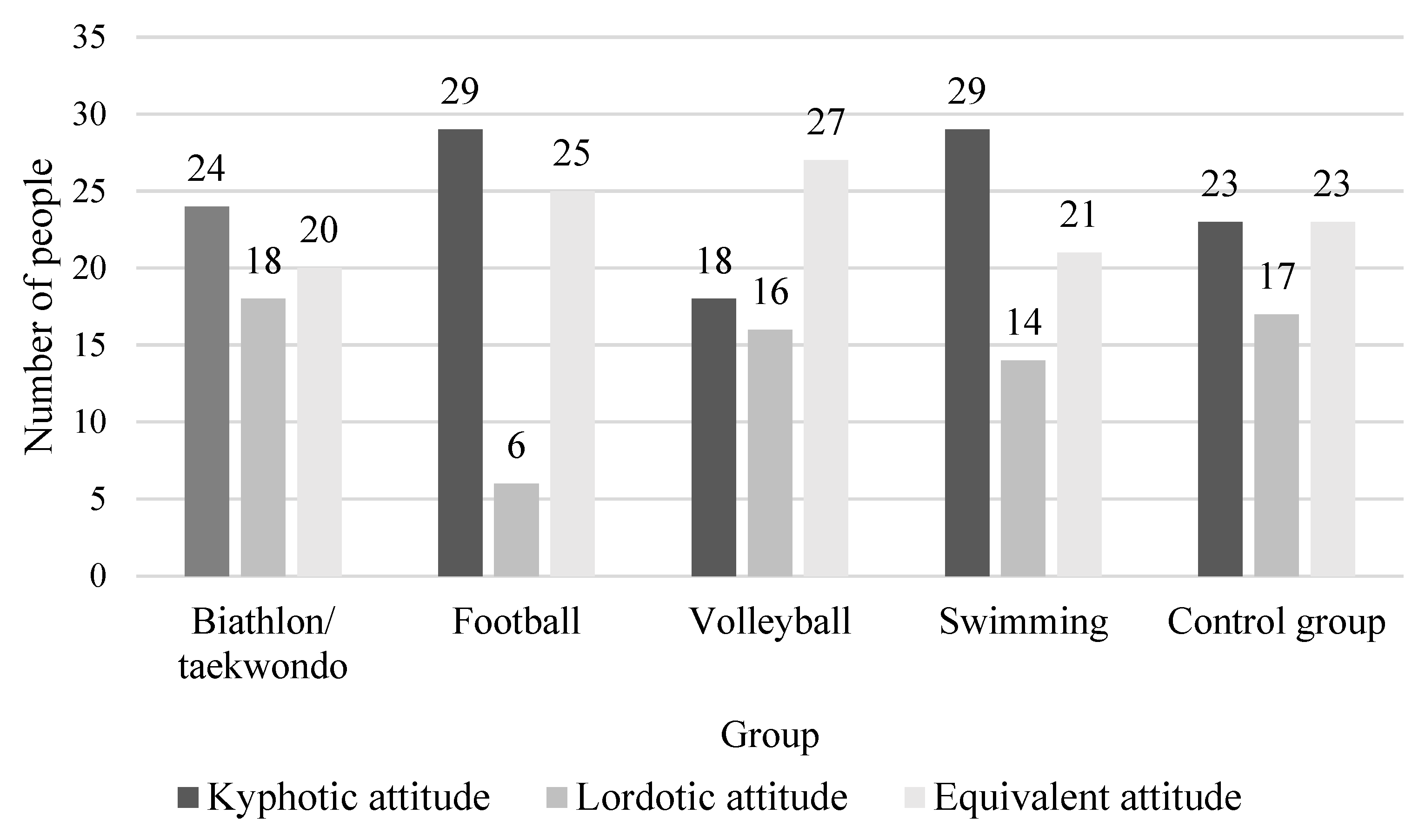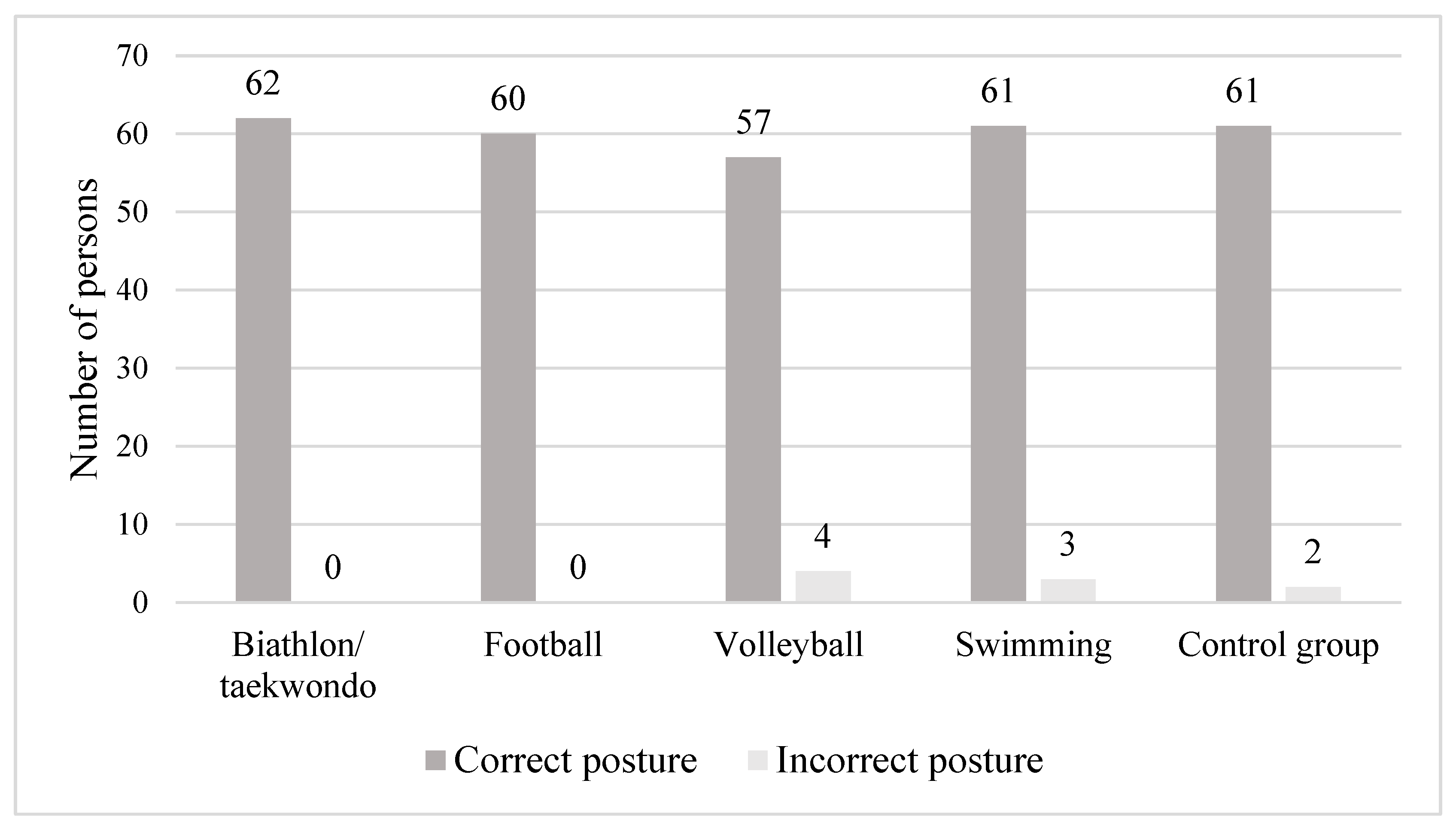The Sizes of Spine Curvatures of Children That Practice Selected Sports
Abstract
1. Introduction
2. Material and Methods
- (a)
- Football (60 persons);
- (b)
- Swimming (64 persons);
- (c)
- Biathlon/taekwondo (62 persons attending the same class in a primary school with a sports profile. All people participated in these physical education classes and had the same general development training. Only the training of the leading sport discipline differed, and the number of training units depended on the age of the trainees);
- (d)
- Volleyball (61 persons).
- Obtaining the written consent of the legal guardian to conduct the examination;
- Attending a sport-profile public primary school or training in a given sport in a club for 6 h a week as a minimum (study group);
- The age of the child being in the range 8.5–13.5 years.
- The exclusion criteria for the study were:
- Severe orthopedic injuries (fracture of the lower limb, inability to fully load the limb);
- Asymmetry of the length of the lower limbs above 2 cm (assessment by physical examination);
- Structural scoliosis (assessment by physical examination);
- The presence of other diseases causing musculoskeletal deformities or structural postural defects;
- Failure to obtain the written consent of the legal guardian to conduct the examination.
- Alpha angle—the inclination of the lumbosacral spine;
- Beta angle—the inclination of the thoracolumbar segment;
- Gamma angle—the inclination of the upper thoracic spine;
- KPP—the size of kyphosis in the thoracic spine;
- KLL—the size of lordosis in the lumbar spine;
3. Results
Analysis of Multivariate Models
4. Discussion
5. Conclusions
Author Contributions
Funding
Institutional Review Board Statement
Informed Consent Statement
Data Availability Statement
Conflicts of Interest
References
- Ćwirlej, A.; Walicka-Cupryś, K.; Gregorowicz-Cieślik, H. Aktywność ruchowa dzieci 10-letnich w czasie wolnym. Przeg. Med. Uniw. Rzesz. 2005, 3, 262–266. [Google Scholar]
- Rosa, K.; Muszkieta, R.; Zukow, W.; Napierała, M.; Cieślicka, M. Częstość występowania wad postawy u dzieci z klas I-III Szkoły Podstawowej. J. Health Sci. 2013, 3, 107–136. [Google Scholar]
- Wojna, D.; Anwajler, J.; Hawrylak, A.; Barczyk, K. Ocena postawy ciała dzieci w młodszym wieku szkolnym. Fizjoterapia 2010, 18, 27–39. [Google Scholar]
- Muchacka, R.; Pyclik, M. Wady postawy u dzieci i młodzieży–charakterystyka i etiologia. Pr. Nauk. 2016, 37, 69–85. [Google Scholar]
- Sławińska, T.; Rożek, K.; Ignasiak, Z. Asymetria ciała w obrębie tułowia dzieci wczesnej specjalizacji sportowej. Med. Sport. 2006, 22, 97–100. [Google Scholar]
- Szabert, A.; Targosiński, P.; Sidaway, M. Metoda MORY w diagnostyce zaburzeń postawy ciała u dzieci. Badanie pilotażowe. Fizjoter. Pol. 2012, 12, 389–396. [Google Scholar]
- Mucha, D.; Ambroży, T.; Ząbek, M.; Wojtala, J.; Szczygieł, A.; Żaba, K.; Mucha, T. Aktywność fizyczna jako warunek prawidłowej postawy ciała u młodzieży. Kult. Bezpieczeństwa Nauka–Prakt.–Refleksje 2015, 19, 139–148. [Google Scholar]
- Furgał, W.; Adamczyk, A. Ukształtowanie sklepienia stopy w zależności od poziomu aktywności fizycznej. Med. Sport. 2008, 5, 311–317. [Google Scholar]
- Wesołowska-Górniak, K.; Wójtowicz, M.; Federowicz, M.; Gierus, J.; Czarkowska-Pączek, B. The level of daily physical activity and methods to increase it in patients after liver or kidney transplantation. Adv. Rehab. 2022, 36, 25–32. [Google Scholar] [CrossRef]
- Janiszewska, R.; Tuzinek, S.; Nowak, S.; Ratyńska, A.; Biniaszewski, T. Nieprawidłowości postawy ciała u dzieci 6-12 letnich – uczniów szkół podstawowych z Radomia – badania pilotażowe. Probl. Hig. Epidemiol. 2009, 90, 342–346. [Google Scholar]
- Grabara, M.; Hadzik, A. Postawa ciała młodych lekkoatletów na tle rówieśników. Med. Sport. 2009, 25, 115–124. [Google Scholar]
- Zerf, M. Body composition versus body fat percentage as predictors of posture/balance control mobility and stability among football players under 21 years. Phys. Educ. Stud. 2017, 2, 96–102. [Google Scholar] [CrossRef]
- de Blasiis, P.; Fullin, A.; Caravaggi, P.; Lus, G.; Melone, M.A.; Sampaolo, S.; de Luca, A.; Lucariello, A. Long-term effects of asymmetrical posture in boxing assessed by baropodometry. J. Sport. Med. Phys. Fit. 2022, 62, 350–355. [Google Scholar] [CrossRef]
- Penha, P.J.; Amado João, S.M.; Casarotto, R.A.; Amino, C.J.; Penteado, D.C. Postural assessment of girls between 7 and 10 years of age. Clinics 2005, 60, 9–16. [Google Scholar] [CrossRef]
- Wawrzyniak, A.; Tomaszewski, M.; Mews, J.; Jung, A.; Kalicki, B. Wady postawy u dzieci i młodzieży jako jeden z głównych problemów w rozwoju psychosomatycznym. Pediatr. Med. Rodz. 2017, 13, 72–78. [Google Scholar] [CrossRef]
- Jankowicz-Szymańska, A.; Mikołaczyk, E. Do posture correction exercises have to be boring? Using unstable surfaces to prevent poor posture in children. Med. Stud. 2016, 32, 116–122. [Google Scholar] [CrossRef]
- Filho, J.N.S.; Batista, L.A.; Gurgel, J.L.; Porto, F. Shadow Moire technique for postural assessment: Qualitative assessment protocol by intra- and inter-rater evaluation. J. Phys. Ther. Sci. 2017, 29, 356–360. [Google Scholar] [CrossRef]
- Mrozkowiak, M.; Strzecha, M. Mora projekcyjna współczesnym narzędziem diagnostycznym postawy ciała. Antropomotoryka 2012, 60, 33–47. [Google Scholar]
- Porto, F.; Gurgel, J.L.; Russomano, T.; Farinatti, P.D.T.V. Moire topography: Characteristics and clinial application. Gait Posture 2010, 32, 422–424. [Google Scholar] [CrossRef]
- De Blasiis, P.; Fullin, A.; Sansone, M.; Del Viscovo, L.; Napolitano, F.; Terracciano, C.; Lus, G.; Melone, M.A.B.; Sampaolo, S. Quantitative Evaluation of Upright Posture by x-Ray and 3D Stereophotogrammetry with a New Marker Set Protocol in Late Onset Pompe Disease. J. Neuromuscul. Dis. 2022, 8, 979–988. [Google Scholar] [CrossRef]
- De Blasiis, P.; Fullin, A.; Sansone, M.; Perna, A.; Caravelli, S.; Mosca, M.; De Luca, A.; Lucariello, A. Kinematic Evaluation of the Sagittal Posture during Walking in Healthy Subjects by 3D Motion Analysis Using DB-Total Protocol. J. Funct. Morphol. Kinesiol. 2022, 7, 57. [Google Scholar] [CrossRef] [PubMed]
- Zeyland-Malawka, E. Klasyfikacja i ocena postawy ciała w modyfikacjach metody Wolańskiego i Nowojorskiego Testu Klasyfikacyjnego. Fizjoterapia 1999, 7, 52–55. [Google Scholar]
- Jankowicz-Szymańska, A.; Imiołek, M. Ruchomość kręgosłupa i jakość postawy ciała 11-letnich piłkarzy ręcznych na tle rówieśników. Med. Sport. 2008, 5, 293–303. [Google Scholar]
- Vařeková, R.; Vařeka, I.; Janura, M.; Svoboda, Z.; Elfmark, M. Evaluation of Postural Asymmetry and Gross Joint Mobility in Elite Female Volleyball Athletes. J. Hum. Kinet. 2011, 29, 5–13. [Google Scholar] [CrossRef]
- Grabara, M. Comparison of posture among adolescent male volleyball players and non-athletes. Biol. Sport 2015, 32, 79–85. [Google Scholar] [CrossRef]
- Kuczyński, M.; Rektor, Z.; Borzucka, D. Postural control in quier stance in the second league male volleyball players. Hum. Mov. 2009, 10, 12–15. [Google Scholar]
- Grabara, M. Analysis of body posture between young football players an their untrained peers. Hum. Mov. 2012, 13, 120–126. [Google Scholar] [CrossRef]
- Oyama, S.; Myers, J.B.; Wassinger, C.A.; Ricci, R.D.; Lephart, S.M. Asymmetric Resting Scapular Posture in Healthy Overhead Athletes. J. Athl. Train. 2008, 43, 565–570. [Google Scholar] [CrossRef]
- Barczyk-Pawelec, K.; Bańkosz, Z.; Derlich, M. Body postures and asymmetries in frontal and transverse planes in the trunk area in table tennis players. Biol. Sport 2012, 29, 129–134. [Google Scholar] [CrossRef]
- Pawlicka-Lisowska, A.; Gątkiewicz, M.; Motylewski, S.; Górecka, U. Postawa ciała a wskaźniki antropometryczne. Kwart. Ortop. 2011, 1, 50–56. [Google Scholar]
- Nowotny, J.; Czupryna, K.; Rudzińska, A.; Nowotny-Czupryna, O. Zmiany postawy ciała w pierwszych sześciu latach nauki szkolnej. Fizjoter. Pol. 2008, 8, 378–383. [Google Scholar]
- Hagner, W.; Bąk, D.; Hagner-Derengowska, M. Zmiany w postawie ciała u dzieci w pierwszych trzech latach nauki szkolnej. Forum. Med. Rodz. 2010, 4, 287–290. [Google Scholar]
- Łubkowska, W.I.; Zdeb, T.; Mroczek, B. Ocena ukształtowania fizjologicznych krzywizn kręgosłupa dziewcząt trenujących sport pływacki i nie uprawiających pływania. Fam. Med. Prim. Care Rev. 2015, 17, 189–192. [Google Scholar] [CrossRef]
- Grabara, M.; Bieniec, A.; Nawrocka, A. Spinal curvatures of children and adolescents—A cross-sectional study. Biomed. Hum. Kinet. 2017, 9, 69–74. [Google Scholar] [CrossRef]




| Group | |||||||
|---|---|---|---|---|---|---|---|
| Parameter | Sex | Biathlon/Taekwondo | Football | Volleyball | Swimming | Control | p |
| n [number of persons] | F | 29 | 0 | 44 | 32 | 28 | - |
| M | 33 | 60 | 17 | 32 | 35 | ||
| Total | 62 | 60 | 61 | 64 | 63 | ||
| Age [years] | F | 10.7 ± 1.3 | - | 11.9 ± 1.0 | 10.3 ± 0.7 | 11.2 ± 1.1 | p < 0.0001 |
| M | 11.1 ± 1.3 | 11.0 ± 1.0 | 11.4 ± 1.2 | 10.4 ± 0.9 | 11.3 ± 1.2 | ||
| Total | 10.9 ± 1.3 | 11.0 ± 1.0 | 11.8 ± 1.1 | 10.3 ± 0.8 | 11.3 ± 1.1 | ||
| Body height [cm] | F | 145.4 ± 7.4 | - | 157.9 ± 11.2 | 143.7 ± 8.0 | 150.4 ± 9.3 | p < 0.0001 |
| M | 148.5 ± 10.2 | 147.0 ± 8.6 | 150.2 ± 7.3 | 147.8 ± 8.0 | 151.7 ± 8.7 | ||
| Total | 147.0 ± 9.1 | 147.0 ± 8.6 | 155.8 ± 10.8 | 145.7 ± 8.2 | 151.1 ± 8.9 | ||
| Body weight [kg] | F | 37.1 ± 6.3 | - | 45.8 ± 11.5 | 35.2 ± 7.7 | 42.9 ± 8.1 | p < 0.0001 |
| M | 39.6 ± 8.2 | 37.0 ± 8.3 | 37.1 ± 5.9 | 38.2 ± 6.7 | 43.9 ± 10.8 | ||
| Total | 38.4 ± 7.4 | 37.0 ± 8.3 | 43.4 ± 10.9 | 36.7 ± 7.3 | 43.4 ± 9.6 | ||
| BMI [kg/m2] | F | 17.5 ± 1.9 | - | 18.1 ± 2.6 | 16.9 ± 2.2 | 18.8 ± 2.3 | 0.0013 |
| M | 17.8 ± 2.2 | 16.9 ± 2.5 | 16.4 ± 1.4 | 17.4 ± 2.3 | 18.9 ± 3.6 | ||
| Group | |||||
|---|---|---|---|---|---|
| Alpha Angle | Beta Angle | Gamma Angle | KPP | KLL | |
| Biathlon/taekwondo | 11.18 ± 4.54 | 4.22 ± 2.60 | 12.83 ± 5.11 | 162.95 ± 5.57 | 164.60 ± 4.59 |
| Football | 11.50 ± 4.39 | 3.18 ± 2.27 | 15.03 ± 3.58 | 161.79 ± 3.66 | 165.32 ± 5.22 |
| Volleyball | 12.17 ± 3.97 | 4.45 ± 3.38 | 12.05 ± 3.57 | 163.50 ± 4.79 | 163.38 ± 4.61 |
| Swimming | 12.30 ± 4.76 | 3.68 ± 2.33 | 13.58 ± 3.69 | 162.74 ± 4.01 | 164.02 ± 5.72 |
| Control | 13.44 ± 4.53 | 3.17 ± 2.48 | 14.37 ± 2.96 | 162.46 ± 3.76 | 163.39 ± 4.68 |
| p | 0.0496 | 0.0165 | 0.0002 | 0.2977 | 0.1510 |
| Power | 60% | 60% | 90% | 43% | 38% |
Disclaimer/Publisher’s Note: The statements, opinions and data contained in all publications are solely those of the individual author(s) and contributor(s) and not of MDPI and/or the editor(s). MDPI and/or the editor(s) disclaim responsibility for any injury to people or property resulting from any ideas, methods, instructions or products referred to in the content. |
© 2023 by the authors. Licensee MDPI, Basel, Switzerland. This article is an open access article distributed under the terms and conditions of the Creative Commons Attribution (CC BY) license (https://creativecommons.org/licenses/by/4.0/).
Share and Cite
Twarowska-Grybalow, N.; Truszczyńska-Baszak, A. The Sizes of Spine Curvatures of Children That Practice Selected Sports. Int. J. Environ. Res. Public Health 2023, 20, 1826. https://doi.org/10.3390/ijerph20031826
Twarowska-Grybalow N, Truszczyńska-Baszak A. The Sizes of Spine Curvatures of Children That Practice Selected Sports. International Journal of Environmental Research and Public Health. 2023; 20(3):1826. https://doi.org/10.3390/ijerph20031826
Chicago/Turabian StyleTwarowska-Grybalow, Natalia, and Aleksandra Truszczyńska-Baszak. 2023. "The Sizes of Spine Curvatures of Children That Practice Selected Sports" International Journal of Environmental Research and Public Health 20, no. 3: 1826. https://doi.org/10.3390/ijerph20031826
APA StyleTwarowska-Grybalow, N., & Truszczyńska-Baszak, A. (2023). The Sizes of Spine Curvatures of Children That Practice Selected Sports. International Journal of Environmental Research and Public Health, 20(3), 1826. https://doi.org/10.3390/ijerph20031826






